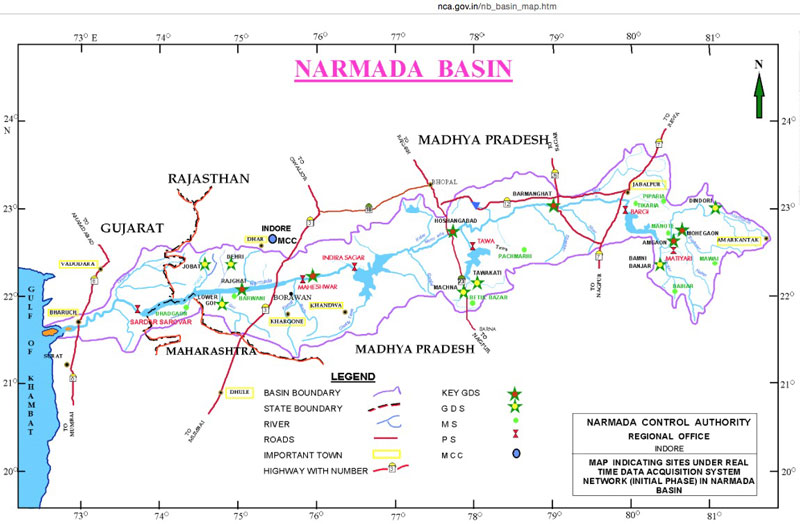
Memories of life in a remote Bhil hamlet on the Narmada river >>
“Those displaced, who are the Scheduled Tribes, belong to the Bhil, Bhilala, Pavra, Tadvi, and Vassawa ethnic groups [of] Gujarat, Madhya Pradesh, and Maharashtra.”
Source: Development and Dispossession in the Narmada Valley >>
Ever since the Narmada Control Authority in its Action Taken Report permitted the raising of the Sardar Sarovar dam to 110.64 metres, the entire tribal belt in the Narmada valley came under the submergence zone. The scale of devastation during this monsoon will depend on the extent of rainfall here. | Read the full article (PDF) >>
Source: “Flood of fears” in Frontline Magazine (India’s National Magazine from the publishers of The Hindu), Volume 21 – Issue 16, Jul. 31 – Aug. 13, 2004
Address : https://www.hinduonnet.com/fline/fl2116/stories/20040813002609400.htm
Date Visited: 22 October 2020
The social characteristics of those displaced by the Sardar Sarovar Dam are not unique, either to India or to the rest of the world. Of the 200,000 to 250,000 who have been displaced by the Sardar Sarovar Dam, 60–70 per cent, are the Scheduled Tribe populations, i.e., those defined by the Indian Constitution to live primarily by pastoralism, subsistence-oriented slash and burn agriculture, and/or hunting and gathering. […]
Those displaced, who are the Scheduled Tribes, belong to the Bhil, Bhilala, Pavra, Tadvi, and Vassawa ethnic groups and are located at the boundaries between the three states of Gujarat, Madhya Pradesh, and Maharashtra. Their rates of education and literacy are low by the all-India standards. Although Scheduled Tribes make up 8 per cent of India’s population, they constitute between 40–50 per cent of those whose lands have faced submergence in the post-Independence period. Reliable estimates of the numbers displaced in India are between 20–38 million people of whom, nearly half belong to the Scheduled Tribes.
Source: Judy Whitehead (University of Lethbridge) in “Development and Dispossession in the Narmada Valley” (Pearson, New Delhi 2010), pp. 6-7
URL: https://www.academia.edu/442943/
Date visited: 4 December 2020
Thirty-three villages in Maharashtra were submerged, 4,300 families displaced. According to data from the Narmada Bachao Andolan, 4,135 families were resettled over the last 25 years. District collector Mallinath Kalshetty says efforts are under way to rehabilitate remaining families.
Source: Tabassum Barnagarwala, The Indian Express, 12 March 2018
URL: https://indianexpress.com/article/india/after-25-years-narmada-dam-sufferer-shown-land-for-resettlement-5094548/
Date Visited: 22 October 2020
Saving the forests of Garhwal by sticking to trees. Fighting a big dam by living in submerged waters. These movements redefined the greening of India.
6. HIGH TIDE
Narmada Bachao Andolan, 1985Narmada Bachao Andolan announced the arrival of the India Greens, protesting against destructive development.“One of the largest and most successful environmental campaigns, Narmada Bachao Andolan began with a wide developmental agenda, questioning the very rationale of large dam projects in India” (India Today, December 2007).
Source: “10 most powerful movements” by Purvi Malhotra (India Today, 19 December 2008)
URL: https://www.indiatoday.in/magazine/environment/story/20081229-10-most-powerful-movements-738539-2008-12-19
Date Visited: 31 May 2021
[Bold typeface added above for emphasis]
Learn more about tribal communities in the Narmada region >>
Reports in the Indian press | List of periodicals included in this search >>
Search tips
Combine the name of any particular state, language or region with that of any tribal (Adivasi) community.
Add keywords of special interest (music, poetry, dance just as health, sacred grove and biodiversity); learn about the rights of Scheduled Tribes such as the “Forest Rights Act” (FRA); and the United Nations “Declaration on the Rights of Indigenous Peoples”, “Universal Declaration of Human Rights”, “women’s rights”, or “children’s right to education”.
Ask a question that includes “tribal” or “Adivasi”, for instance: “Adivasi way of life better?” (or “tribal way of life worse?”)
Specify any particular issue or news item (biodiversity, bonded labour and human trafficking, climate change, ecology, economic development, ethnobotany, ethnomedicine, global warming, hunter-gatherers in a particular region or state, prevention of rural poverty, water access).
For official figures include “scheduled tribe ST” along with a union state or region: e.g. “Chhattisgarh ST community”, “Himalayan tribe”, “Scheduled tribe Tamil Nadu census”, “ST Kerala census”, “Particularly Vulnerable Tribal Group Jharkhand”, “PVTG Rajasthan”, “Adivasi ST Kerala”, “Adibasi ST West Bengal” etc.
In case the Google Custom Search window is not displayed here try the following: (1) toggle between “Reader” and regular viewing; (2) in your browser’s Security settings select “Enable JavaScript” | More tips >>
Note: hyperlinks and quotes are meant for fact-checking and information purposes only | Disclaimer >>
Research the above issues with the help of Shodhganga: A reservoir of theses from universities all over India, made available under Open Access >>